The Fingertip Myth
For as long as I can remember, I’ve been telling students that they must play with their left hand finger tips. This is the strongest position and yields the best sound.
The reality is, however, not so clear cut.
The Easy Doctrine
If there’s one overarching philosophy I try to preach on the classical guitar blog it is to be profoundly lazy. That is, do the least amount of work required to achieve the desired result.
To that end, the left hand fingertips advice is not set in stone. There’s a variety of situations in which playing with the fingertips less than perpendicular makes things easier.
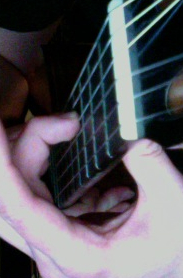
A Few Examples
Reaching the lower strings using more of the fingertip pads can make things easier. Especially notice that the first and fourth fingers tend to be more on their pads (a consequence of them being a bit shorter on most people).
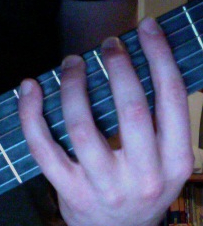
In the same way reaching bass notes will holding down notes on the treble strings sometimes necessitates a bit of pad playing. Notice the fourth finger in this chord shape from the Coda of Giuliani’s Variations on Folies d’Espagne.
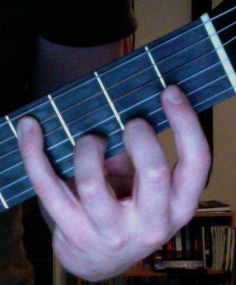
Our muscles are the strongest and most efficient in their mid-range of movement. Sometimes playing more on the pads of the fingers lets us keep finger joints more in the mid-range. Check out this angled hand position. The fourth finger, once again, can be a on its pad a bit.
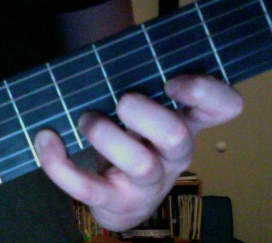
Another, often overlooked use of pad playing in the hinge bar. Doing a hinge bar requires that the first finger remain more on its pad then fingertip.
Where On the Fingertips Anyway
Not all fingertips will be straight on the strings. A straight wrist position puts the fingers one and four on their outside edges.

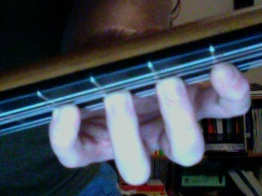
As I said above: make it easy. If using more of the pad does that without compromising sound and clarity, do it! If not, trash it. This is not an excuse to play sloppily, but something to think about the next time you work through a piece.

Bradford Werner
There is one exercise I always assign for the fingertip/hand position: Scales or Giuliani exercises in 3rds. The thirds require the fingers to be on their fingertips or one of the strings will become muted. It’s something I can send them home with and know that it will come back correct.
Kirk Keathley
Excellent article. I would add that using the described position to intentionally mute another string is another good example of when not to use perfect position.
The Week in Links (March 27th) | Classical Guitar Canada
[…] The Fingertip Myth (www.classicalguitarblog.net) […]
Newbie: ar their classical guitars (for adults) with narrower necks than the usual classical guitar? I have small hands for a man (and I imagine that many Oriental players may have small hands relative to western players. Thanks!
From Newbie: are their classical guitars (for adults) with narrower necks than the usual classical guitar? Necks more similar to folk guitar necks in width I have small hands for a man (and I imagine that many Oriental players may have small hands relative to western players). Thanks! Neil
Christopher Davis
I”m not sure. It’s more common that they make guitars with a shorter scale length than narrow fretboard.
Emil Espinosa
Cordoba guitars have a Fusion model with a narrower neck. I have smaller hands and prefer a shorter scale, (640mm seems optimal) I find the narrower neck is inadequate for the classical guitar repertoire and have tried guitars with a wider than standard fretboard that were easy for me to play. For someone with smaller spans, I would recommend the narrower neck for single note, lead style playing , no big chords…
Dave Pelham
I have several classical guitars and since I build guitars, too, I am rather compulsive about measurements. The neck width at the nut varies from 1 7/8 in. to 2 1/8 in. 2 1/16 in. is most common and, if there is a “normal” this would be it. Flamenco guitars are usually at the wide end of the spectrum at 2 1/8 in. The 1 7/8 in. instrument I own was made by Ernest Koroskenyi in about 1966. It is a beautiful guitar and a joy to play, but I prefer a little wider neck.
Christine Massey
I have a classical guitar made by Koroskenyi about 1967 and would love more information about him – do you have any info??????? I want to get it appraised and have some idea of the value of this beautiful guitar. Please help oif you know anything. Thanks
Peter Hughes
My question relates to a situation where the little (pinky) finger has to reach a fret on the base side, e.g. a D-major chord in second position with the pinky on the 5th fret of the 4th string. As well as moving the left elbow towards the body, do you think it should be pushed forward a little? This would cause the wrist to be more arched and so lift pads of the fingers away from adjacent strings. It seems to me that when I try to “play on the tips” I have to think about how far forward my elbow should move.
Christopher Davis
I think you’re spot on, Peter. You do have to move the elbow forward a little ways. You can also try moving the left hand thumb towards the ceiling a bit. I find that helps me get a more an arch in my fingers and get more on the fingertips when necessary.
Steve Bondy
I think the fingertip myth has its roots in the students’ early stages of playing, when we find out that we MUST play on our fingertips to let the next higher string ring out. It’s during this vulnerable period of our development that we work very hard on this technique. Then, it’s a bit of cognitive dissonance to realize that while we worked so hard on it earlier on, we have to (at the very very least) relax our ideas around it.
Playing on the pads is often easier, and generally speaking gives less string noise. It all depends on context!